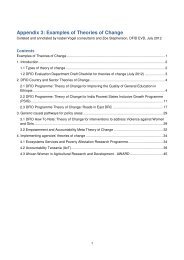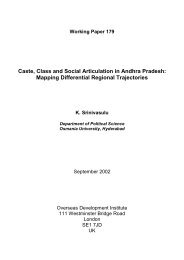Full Report - Research for Development - Department for ...
Full Report - Research for Development - Department for ...
Full Report - Research for Development - Department for ...
You also want an ePaper? Increase the reach of your titles
YUMPU automatically turns print PDFs into web optimized ePapers that Google loves.
and birthing care services, including the costs of promoting behaviour change to<br />
encourage the use of skilled care in different districts of Tanzania and Kenya<br />
(Boulenger and Dmytraczenko, 2007).<br />
Synthesis results<br />
It is also possible to use economic modelling techniques to look at the economic<br />
case <strong>for</strong> scaling up access to a package of appropriate services. One excellent<br />
example of a high-quality modelling study, by Goldie et al. (2010), sought to look at<br />
this across rural and urban areas in India. While it does not indicate methods by<br />
which access would be increased, nor look specifically at the urban poor population,<br />
it does illustrate that scaling up services can be very cost effective. Reducing the<br />
level of unmet need <strong>for</strong> family planning services alone, or coupled with the<br />
elimination of unmet need <strong>for</strong> safe abortion services, would be very cost effective,<br />
reducing the lifetime risk of death due to maternal complications in urban India from<br />
1 in 119 to 1 in 155 or 1 in 173 respectively. Projected costs avoided <strong>for</strong> a single<br />
cohort of 15-year-old women over their lifetimes could be as much as US$ 120<br />
million. A package of measures to scale up fully integrated services, including<br />
intrapartum care as well as family planning and abortion services, would have an<br />
incremental cost per year of life saved of between US$200 and $900. This would be<br />
considered cost effective in an Indian context. Darmstadt et al. (2008) also modelled<br />
the cost-effectiveness of scaling up 16 interventions to tackle infant mortality in 60<br />
low income countries in sub-Saharan Africa and south-east Asia. Scaling up of<br />
intrapartum care, in particular given the more limited availability of services in<br />
these countries was shown in this economic modelling exercise to be the most cost<br />
effective strategy if a step-wise approach to scaling up was required due to limited<br />
resources. Similarly Adam et al. (2005), in observing that there are a number of cost<br />
effective maternal and child health interventions, suggested that scaling these up to<br />
95 percent population coverage would halve neonatal and maternal deaths.<br />
The evidence base might also be strengthened by looking at literature from<br />
countries that were excluded on the grounds of their World Bank classification, but<br />
that nonetheless have large disparities in income and access to maternal and infant<br />
health services. For example, Horton et al. (1996) looked at the cost-effectiveness<br />
of breastfeeding promotion programmes in Brazil and Mexico, concluding that they<br />
are among the best value buys <strong>for</strong> policy makers who wished to reduce the incidence<br />
and number of diarrhoea-related deaths. As this study noted, ‘maternity services<br />
that have already eliminated <strong>for</strong>mula [through promotion of breast feeding] can, by<br />
investing from $2 to $3 per birth, prevent diarrhoea cases and deaths <strong>for</strong> $3.50 to<br />
$6.75 per case, and $550 to $800 per death respectively, with DALYs gained at $12<br />
to $19 each’. The results of this economic analysis might be adapted to low and<br />
middle income country settings to provide further in<strong>for</strong>mation on the potential costeffectiveness<br />
of promotion programmes.<br />
4.2 Synthesis of evidence: causal chain analysis<br />
The causal chain analysis included papers of high quality only (n=21). These were<br />
studies that scored ++ in both the internal and external validity checklist. For the<br />
reasons highlighted in Section 3.2, we will only conduct a narrative causal chain<br />
analysis based on these 21 studies. They are subdivided <strong>for</strong> neonatal/infant and<br />
maternal interventions.<br />
What are the effects of different models of delivery <strong>for</strong> improving maternal and infant health<br />
outcomes <strong>for</strong> poor people in urban areas in low income and lower middle income countries? 45









